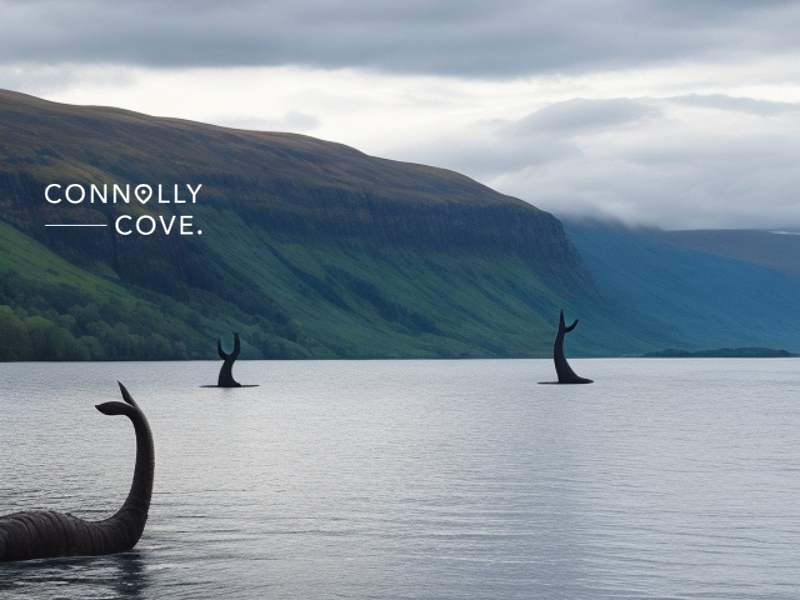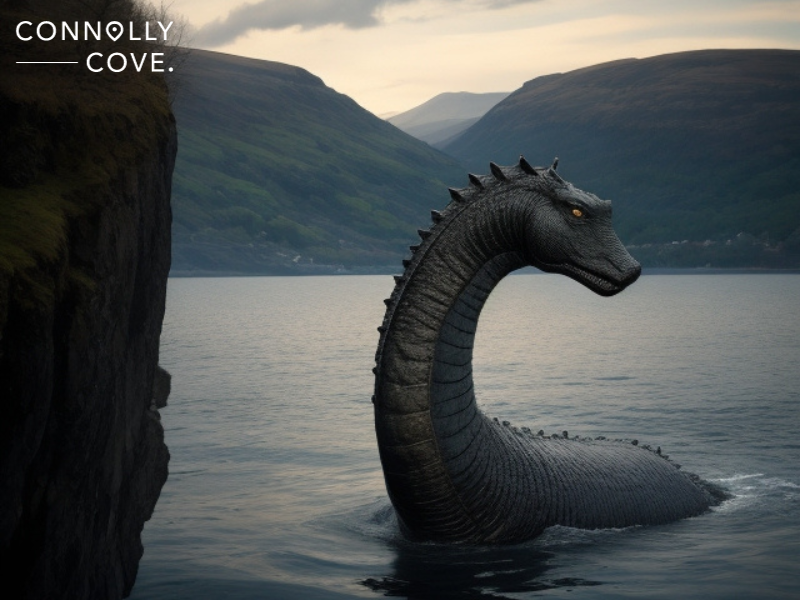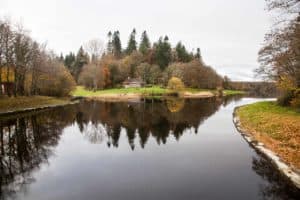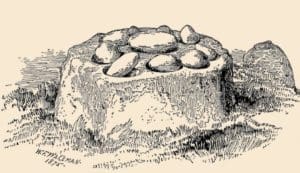Nessie: Exploring The Alluring Legend of Scotland’s Loch Ness Monster

Updated On: November 27, 2023 by Noha Basiouny
Deep in the Scottish Highlands, amidst the tranquil beauty of its rugged landscape, lies a body of water shrouded in legend and folklore—Loch Ness. Home to one of the world’s most enduring mysteries, this expansive lake has captivated the human imagination for centuries. The Loch Ness Monster, affectionately known as Nessie, is more than a mere creature; it is a symbol of mystery, challenging scientists and enthusiasts alike with its elusive nature.
As each generation confronts the riddle afresh, with sophisticated technology and a sceptical eye, in the hope of unravelling its secrets, the tale of the Loch Ness Monster endures, stirring curiosity and debate among sceptics and believers and reflecting humanity’s eternal affection for mystery and the unexplained.
This article delves into the depths of Loch Ness’s waters, exploring historical accounts, scientific investigations, and the cultural impact of its most famous inhabitant. We will examine the compelling narratives and scrutinise the purported evidence that has fuelled the legend of the Loch Ness Monster, which itself has, for so long, captured the hearts and curiosities of adventurers around the globe.
The Loch Ness Monster

So what exactly is the Loch Ness Monster? Is it a remnant of the prehistoric past? A trick of the light? Or is it a phenomenon yet to be explained?
Well, there seems to be a lot to say about that.
The Loch Ness Monster, also referred to as Nessie, is a legendary creature that is said to live in Loch Ness, a large, elongated freshwater lake in the Scottish Highlands—loch is the Scottish term for a lake or sea inlet. But before we get more into the legend of the monster, let’s learn a thing or two about the home it is said to inhabit.
Loch Ness is one of a chain of interconnected, murky bodies of water in Scotland, stretching for 37 kilometres and having an average width of 1.5 kilometres. With an area of 56 square kilometres, Loch Ness is actually the second largest lake in Scotland after Loch Lomond. Yet, as it is way deeper, 227 metres compared to the 190 metres of Loch Lomond, Loch Ness is the largest by volume in all of Great Britain.
The lake is named after River Ness, which flows from its northern end, much like Lake Victoria and the River Nile in Africa, and just like Lake Victoria, Loch Ness has exceptionally low visibility. This is a result of the high peat content from the surrounding soil, a feature that has fuelled the legend the loch bears.
As a part of the global ecosystem, Loch Ness is home to a variety of wildlife, including a range of fish species like salmon, trout, and eels. The surrounding areas of the loch support various species of birds, deer, and other Scottish wildlife. However, all of that seems to have been overshadowed by the myth of the Loch Ness Monster.
Origin
We hear you asking, “Where did this myth come from anyway?”
Well, the origin of the legend dates back to centuries, with a mix of historical accounts and folklore that has been passed down through generations.
In Scottish folklore, there are tales of water horses (known as kelpies or each-uisge), which are said to haunt the rivers and lochs. These shape-shifting entities could appear as beautiful horses or handsome men to lure women and children into the water, only to drown and devour them. These storeys may have contributed to the early legends around what lurks in Loch Ness.
The earliest known report of a monster in the vicinity of Loch Ness is found in the Life of St. Columba by Adomnán, written in the seventh century. According to this text, the Irish monk Saint Columba encountered a giant “water beast” in the River Ness in 565 AD. He is said to have saved a man from being attacked by this creature with the power of prayer, commanding the beast to “go back”, and it complied.
However, the legend of the Loch Ness Monster as we know it today began to take shape in the 20th century. It was sparked in 1933 when a local newspaper, The Inverness Courier, reported an account of a couple who claimed they had seen “an enormous animal rolling and plunging on the surface.” This report is often considered the birth of the modern Nessie legend, which itself led to more claimed sightings.
Sightings

According to the Loch Ness Centre in the Highland village of Drumnadrochit, there has been an extensively large number of sightings where people claimed they had seen the monster. While most of these sightings did not provide any actual evidence, some of them did, which charged the legend even more. Here are some of the most famous recorded sightings of the Loch Ness Monster.
Surgeon’s Photograph (1934)
One of the most famous sightings of the Loch Ness Monster is the 1934 “Surgeon’s Photograph.”
The photograph shows what appears to be the head and neck of a giant creature rising out of the water. It was taken by Robert Kenneth Wilson, a London gynaecologist. When the photo was published in the Daily Mail, it became an instant sensation.
For so long, this photograph solidified the belief that the Loch Ness Monster did exist. However, in the 1990s, Surgeon’s Photograph was revealed to be a hoax in a series of articles published in the British newspaper The Sunday Telegraph, and this storey is just as enchanting as that of the Loch Ness Monster itself.
As it turned out, the hoax was allegedly made up by Marmaduke Wetherell, a big-game hunter who had been publicly mocked by the Daily Mail after he mistook a hippopotamus footprints for those of the Loch Ness Monster. This apparently hurt Wetherell so much that he insisted on taking revenge.
So Wetherell conspired with several accomplices, including his son-in-law Christian Spurling, who was a model maker. They used a toy submarine as the base of their “monster,” attaching a head and neck made of wood putty. The small model was then floated in the loch and photographed, producing the grainy image that was later presented as evidence of the monster.
Robert Kenneth Wilson, the so-called “surgeon”, was not directly involved in the creation of the hoax. However, he agreed to have his name associated with the photograph to lend it credibility, as he enjoyed a good practical joke and also because a doctor was likely to be viewed as a reliable witness.
The exposure of the hoax was primarily due to the confession of Christian Spurling, who, on his deathbed in 1993, admitted to his involvement in the scheme. This confession was reported by the researcher David Martin and journalist Alastair Boyd.
The Dinsdale Footage (1960)
The Dinsdale Footage is a significant piece of visual evidence in the lore of the Loch Ness Monster.
It was captured by Tim Dinsdale, an aeronautical engineer, on 23 April 1960. Dinsdale, who was at Loch Ness hunting for the monster, described seeing a large creature rolling in the water before it started moving. Dinsdale quickly used his 16mm cine camera to film the hump. The footage lasts for about four minutes and shows a hump crossing the water leaving a powerful wave.
According to Dinsdale, when the object was closest, it appeared to be a large, animate object around the size of a boat with a back like an elephant.
The footage received significant media attention and added fuel to the already growing interest in the Loch Ness Monster. It has been subjected to various interpretations over the years, with no absolute consensus. While some see it as compelling evidence of an unknown creature in Loch Ness, others are convinced that it is either a case of mistaken identity or deliberate hoaxing.
The Holmes Video (2007)
The Holmes video is another intriguing chapter in the long saga of the Loch Ness Monster.
Captured on 26 May 2007 by a 55-year-old lab technician named Gordon Holmes, the video features, as Holmes described it, “a jet-black object, about 14 metres long, moving quickly through the water.” When the video was broadcast by BBC Scotland, it quickly gained significant attention due to its clarity compared to previous footage of alleged Nessie sightings.
Despite this clarity, sceptics were quick to point out that the video did not provide conclusive evidence of Nessie’s existence. Further analysis was conducted to discern whether the object could have been an animal, boat wake, or other mundane phenomena, but no definitive explanation was provided that satisfied all parties.
Apple Maps Image (2014)
In 2014, an image of what appeared to be a creature in Loch Ness was captured by Apple Maps. The image shows a long, dark shape in the water that some people believe could be the Loch Ness Monster. However, others have suggested that it could be a boat or a log.
The image has sparked renewed interest in the legend of the Loch Ness Monster, but its authenticity has not been confirmed.
Theories
As the origins of the Loch Ness Monster are shrouded in mystery, while the claimed sightings did not bring back any proof for the existence of the monster, conflicting theories and legends surrounding it came out anyway to explain what this creature could be.
Let’s explore some of these theories.
Prehistoric Creature
One theory, for instance, suggests that the Loch Ness Monster is a surviving plesiosaur. This is a type of marine reptile that lived during the Jurassic period, some 200 million years ago.
As you may have guessed, this theory has been widely discredited by scientists, for it is highly unlikely that a prehistoric creature could have survived for millions of years in a single lake.
Misidentified Animal
Many sightings of the Loch Ness Monster may actually be misidentified animals. For example, some people may mistake large fish or seals for the monster. There have also been reports of sightings of otters, deer, and other animals in the area that may have been mistaken for the monster.
Another theory suggests that the Loch Ness Monster is a giant eel or catfish, which could explain the long, serpentine shape that many eyewitnesses have reported seeing. However, there is little evidence to support this theory as the monster had never been captured to examine it, let alone being clearly sighted. So, this theory remains a subject of debate among researchers and enthusiasts.
Mythical Monster
One popular legend surrounding the origins of the Loch Ness Monster involves a Celtic goddess known as Cailleach Bheur, who was said to have created the creature in a fit of anger. According to this legend, the goddess was angered by the construction of a road near the lake, and she created the Loch Ness Monster as a warning to humans to respect the natural world.
Well, we know what you are thinking.
Optical Illusion
Another theory is that the sightings of the Loch Ness Monster are simply optical illusions caused by the way light reflects off the water. The Loch is known for its deep waters, which can cause waves and currents that can create unusual shapes and shadows on the surface. Some people may mistake these shadows for the humps of a large creature.
Seismic Gas
Some believe the Loch Ness Monster is actually a result of seismic activity in the area. According to this theory, the monster is actually a large bubble of gas that rises to the surface of the Loch. The gas bubble can create a disturbance on the surface of the water, which some people may mistake for a large creature.
Scientific Investigations
Despite the many theories and explanations, nothing could prove the existence of the Loch Ness Monster. While some people continue to believe in the legend, others remain sceptical. That is why there needed to be some legitimate search for evidence.
Scientific investigations into the Loch Ness Monster have been carried out with various degrees of scientific rigour over the years. From the 1960s onwards, researchers used sonar to scan Loch Ness for unusual activity. While some efforts returned unexplained sonar “contacts,” nothing conclusive was found.
Underwater photography was also employed, leading to several ambiguous images that some interpreted as evidence of a large creature.
In 2019, a team of scientists led by Professor Neil Gemmell from the University of Otago in New Zealand conducted a DNA study of the waters of Loch Ness. The study involved collecting water samples from different locations in the Loch and analysing the DNA present in the samples.
The study found no evidence to support the existence of a large aquatic creature such as the Loch Ness Monster. Instead, the DNA analysis revealed a diverse range of organisms, including fish, birds, and invertebrates, that are commonly found in freshwater environments.
While the study did not conclusively disprove the existence of the Loch Ness Monster, it did provide evidence that the creature is unlikely to be a large reptile or dinosaur, as some theories suggest. The study also highlighted the potential of DNA analysis as a tool for investigating other mysteries of the natural world.
Cultural Impact
Despite the many theories and legends surrounding its origins, the Loch Ness Monster remains one of the most ongoing mysteries of the natural world. While many people believe that it is simply a myth, there are still those who continue to search for evidence of its existence, hoping to unlock the secrets of this elusive creature, which has become a significant cultural icon with widespread impact.
Nessie’s legend has had a great impact on tourism in Scotland. Loch Ness has become one of Scotland’s most popular tourist attractions as millions of people from all over the world visit the lake each year in the hope of catching a glimpse of the elusive creature.
The Loch Ness Monster has also been responsible for the creation of a thriving tourism industry in the region, with fantastic hotels, restaurants, souvenir shops, and boat tours all catering to the demand from Nessie enthusiasts.
The Loch Ness Monster has also been a major influence on popular culture. Nessie has been featured in a multitude of books, films, and television shows, ranging from horror and suspense to children’s storeys. The creature often serves as a narrative device to explore themes of mystery, exploration, and the unknown.
For instance, Nessie appeared in Arthur Conan Doyle‘s The Lost World and Michael Crichton’s Loch Ness. It has also been the subject of many films, including The Creature from the Black Lagoon (1954), Nessie (1996), and Loch Ness Terror (2008).
It does not even stop here. The images of the Loch Ness Monster are used to sell a variety of merchandise, from plush toys to Scottish whisky. Businesses capitalise on the Nessie legend, which serves as a unique selling point for products and services.
In addition, the search for Nessie has sparked interest in scientific fields such as cryptozoology, marine biology, and environmental science. It is often used as a case study in critical thinking and the scientific method, especially in educational settings.
Nessie’s legend has captured the world’s imagination for decades, transforming a deep Scottish loch into the abode of one of the most beloved and enduring myths of our time. Despite the lack of irrefutable scientific evidence to support Nessie’s existence, the legend continues to thrive, fuelled by a combination of historical accounts, tantalising photographs, and the universal human fascination with the unknown.
Whether as a symbol of natural mystery, a challenge to the curious, or simply a testament to the power of legend, Nessie has become an emblem of Scottish identity, contributing to the country’s mystique and allure. It is a narrative that not only enriches Scottish culture but also invites us to ponder the depths of both the natural world and our collective imagination.






